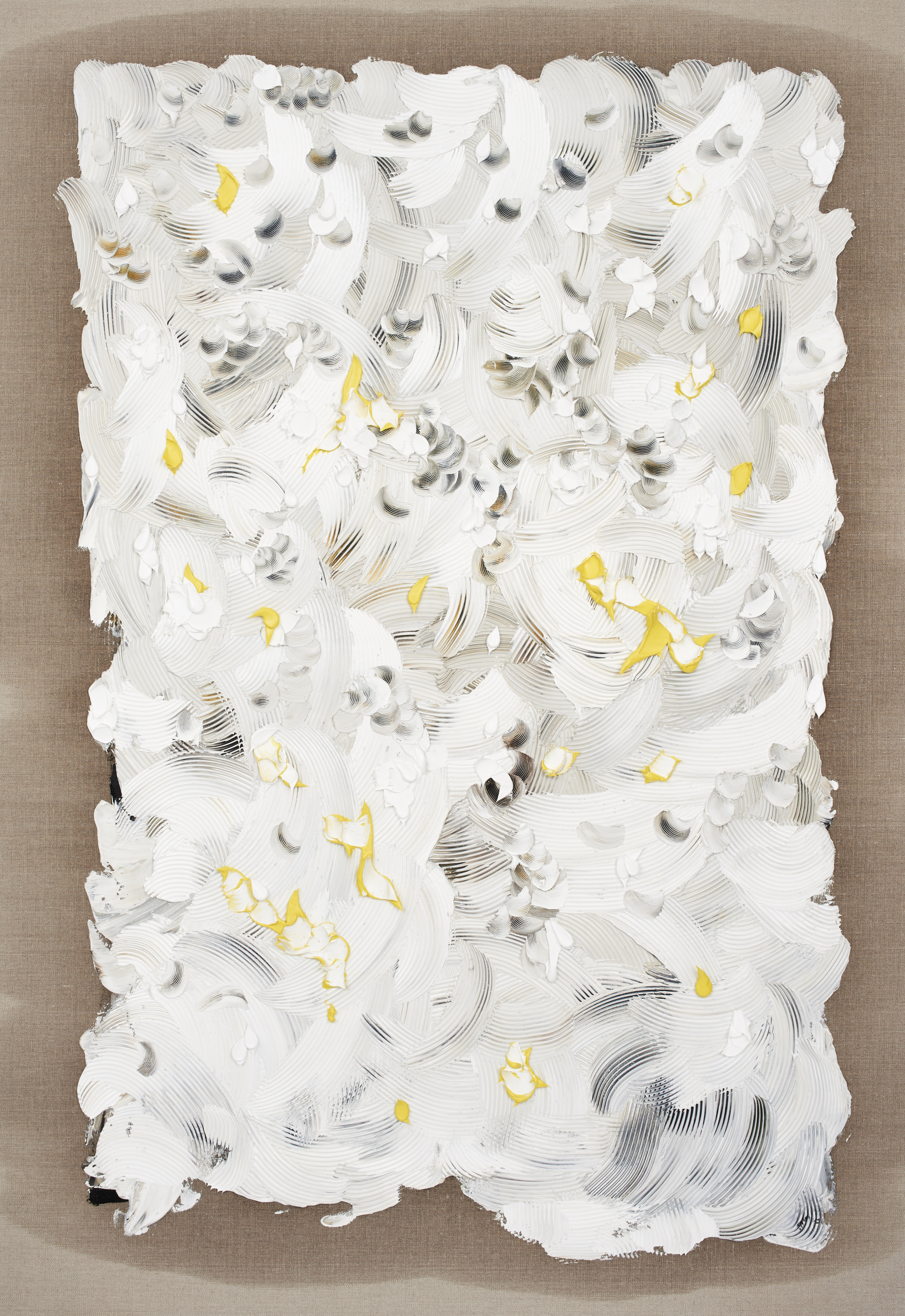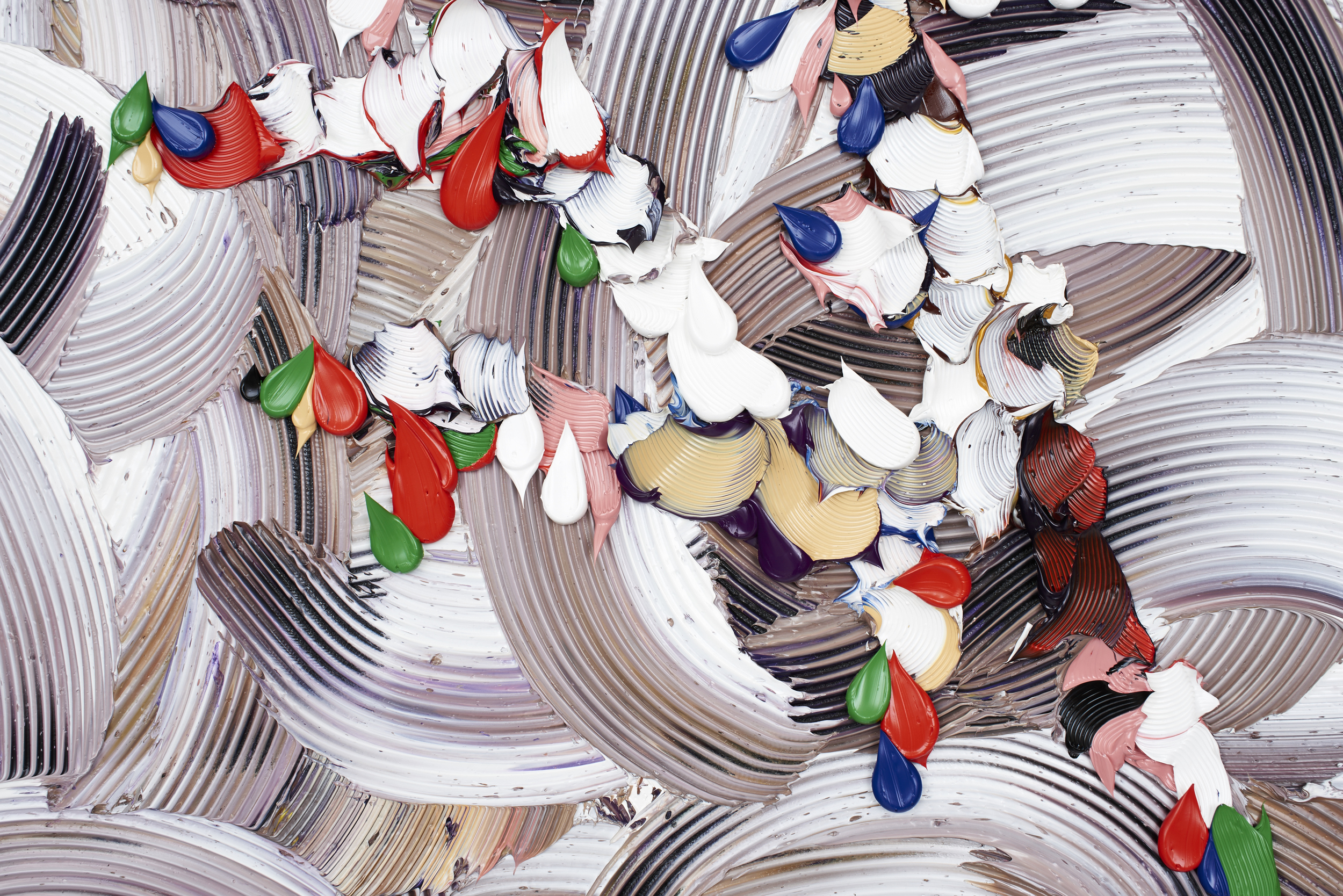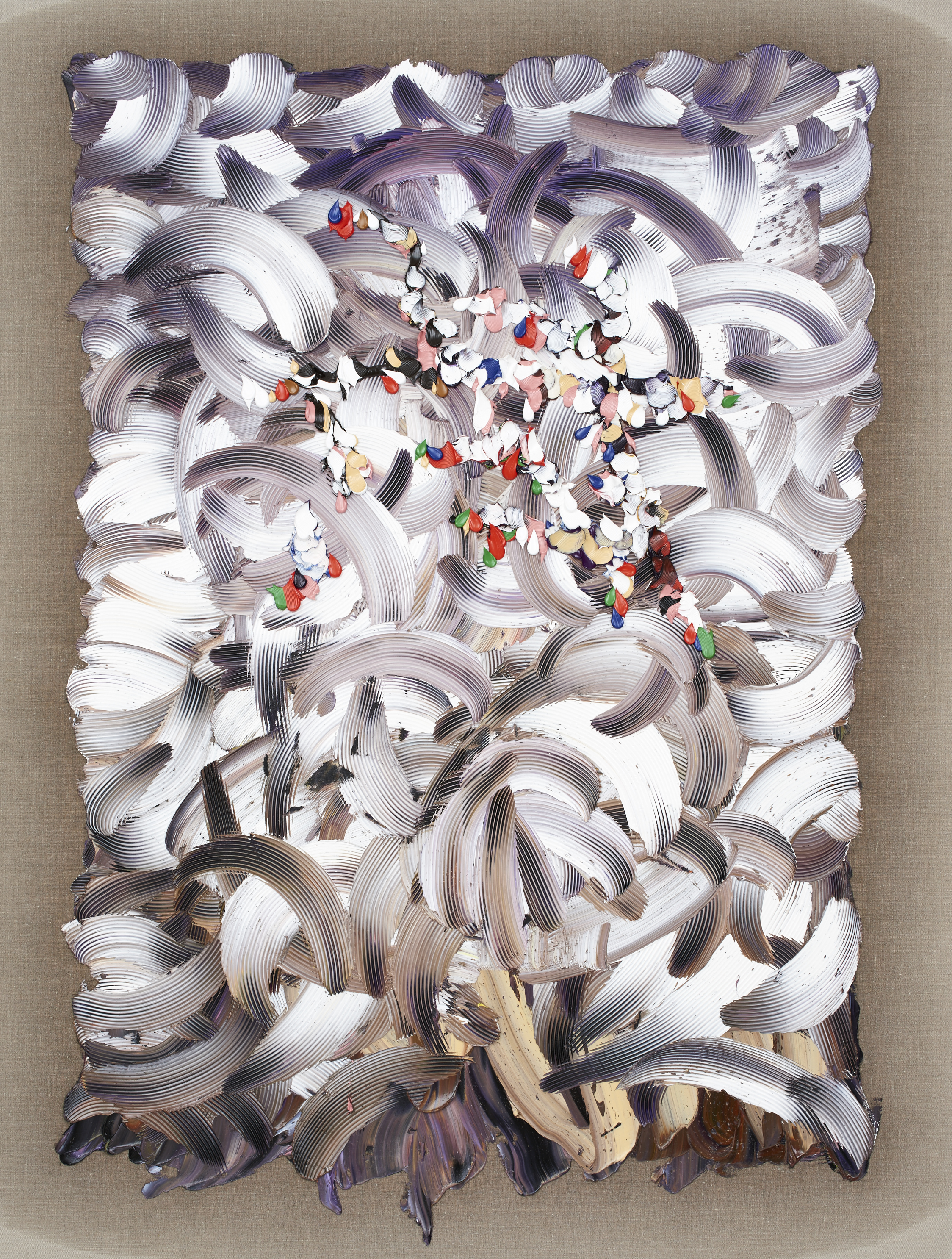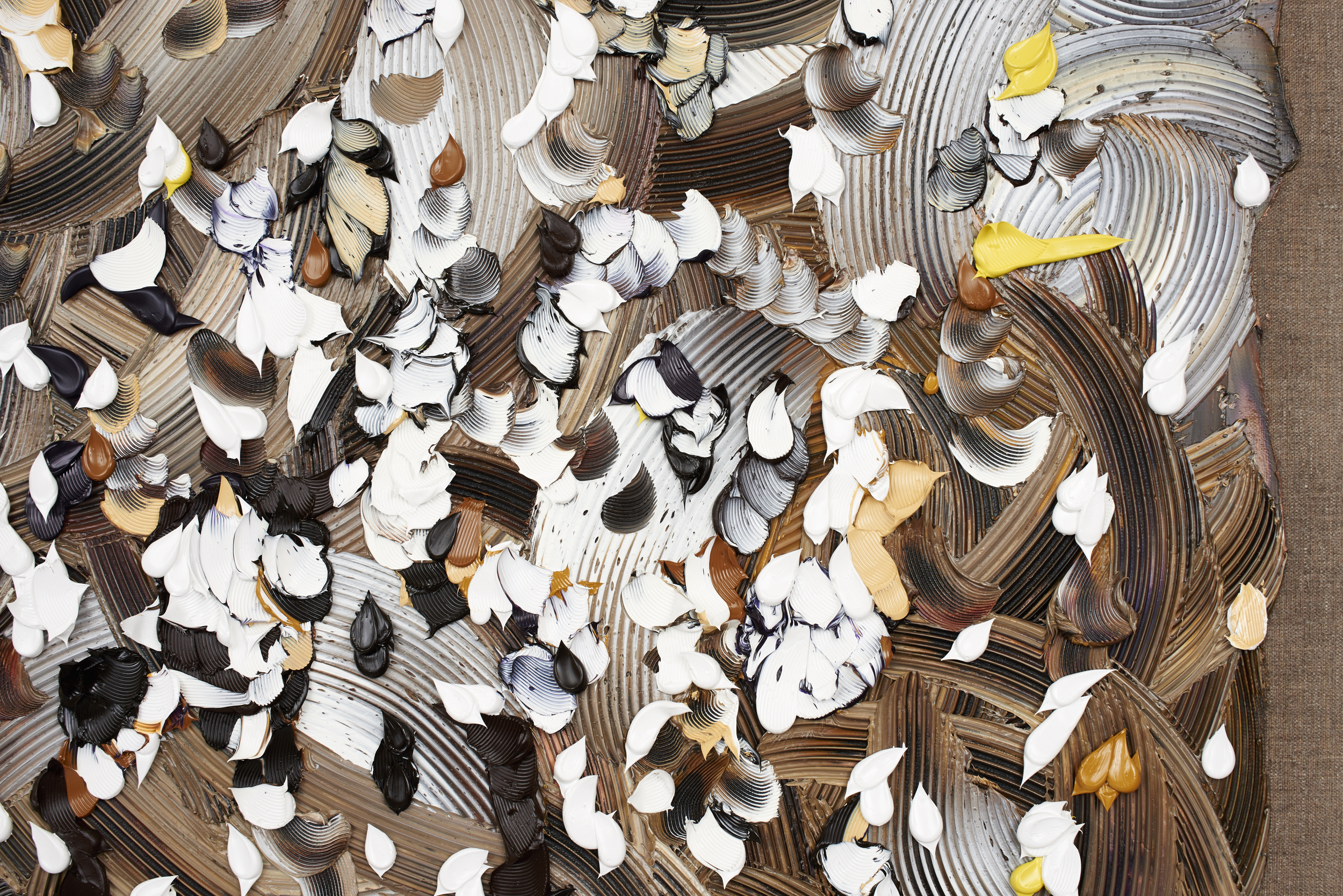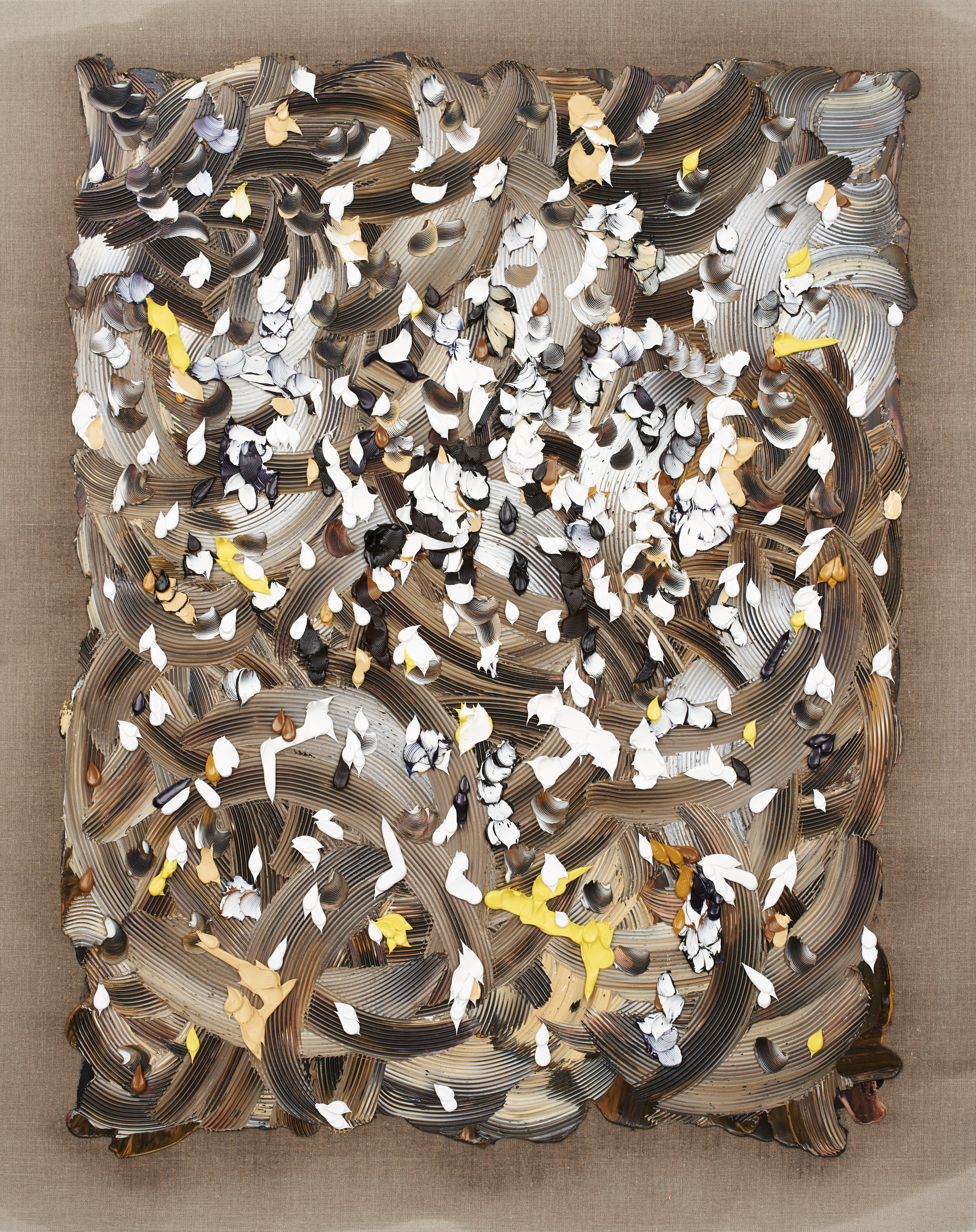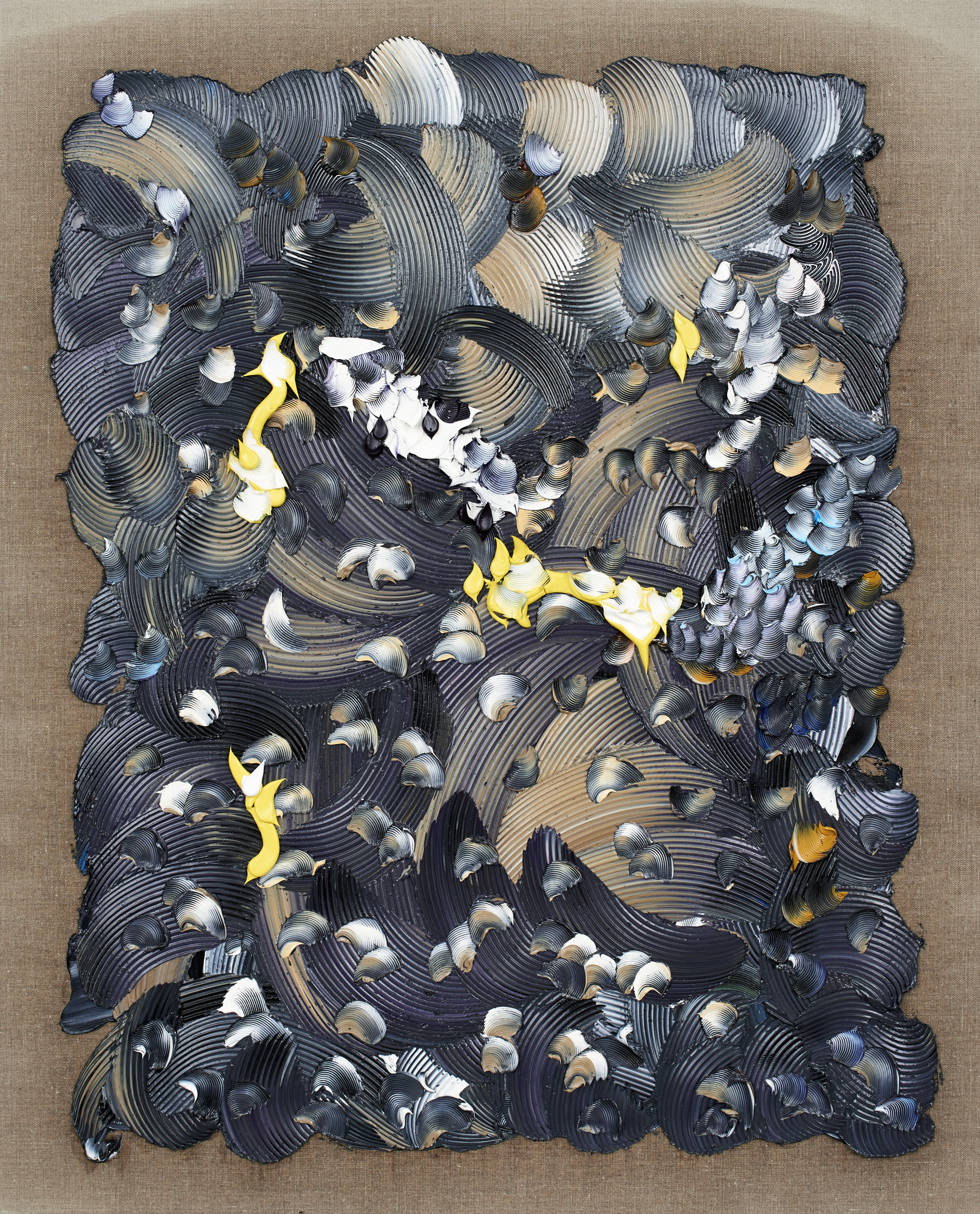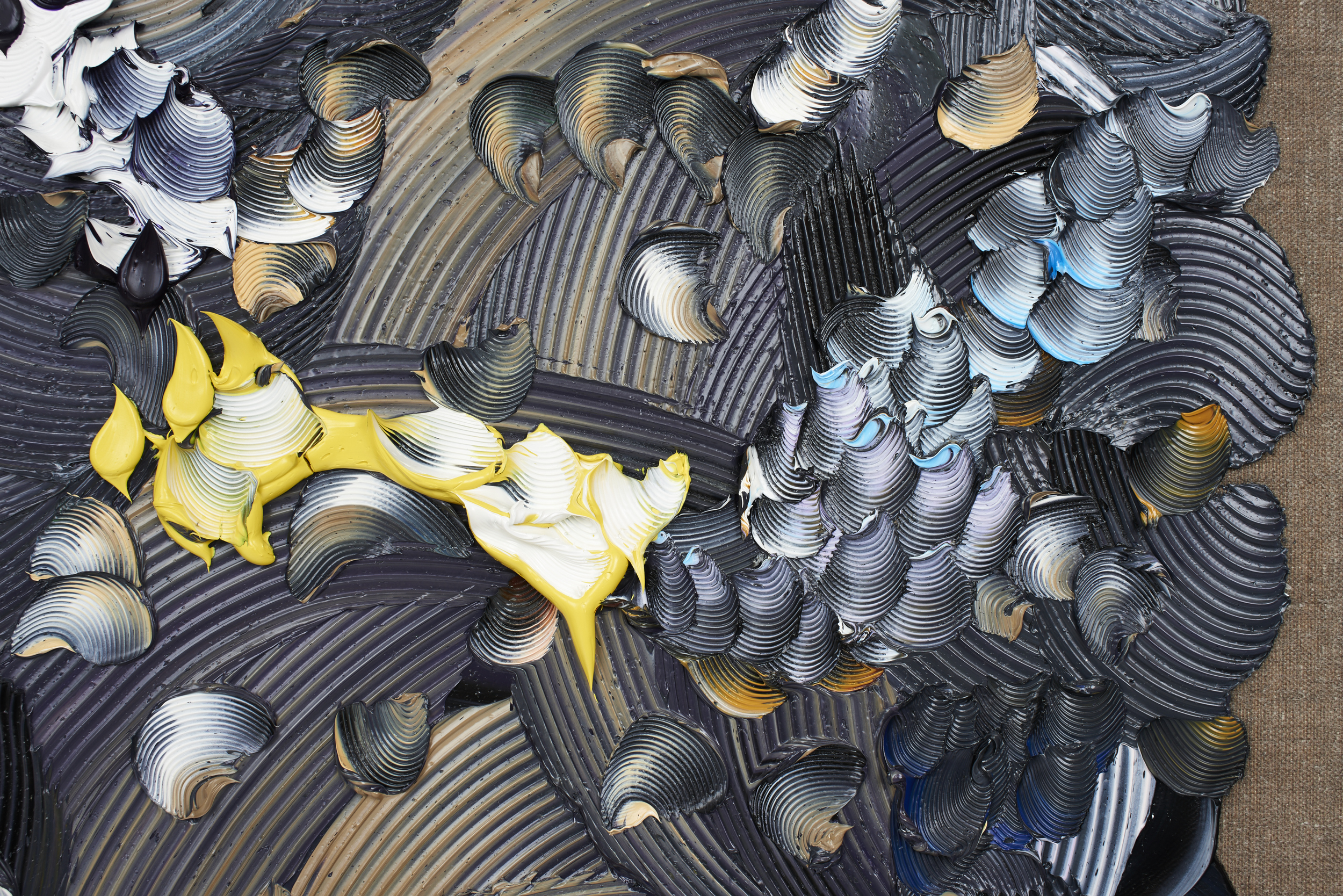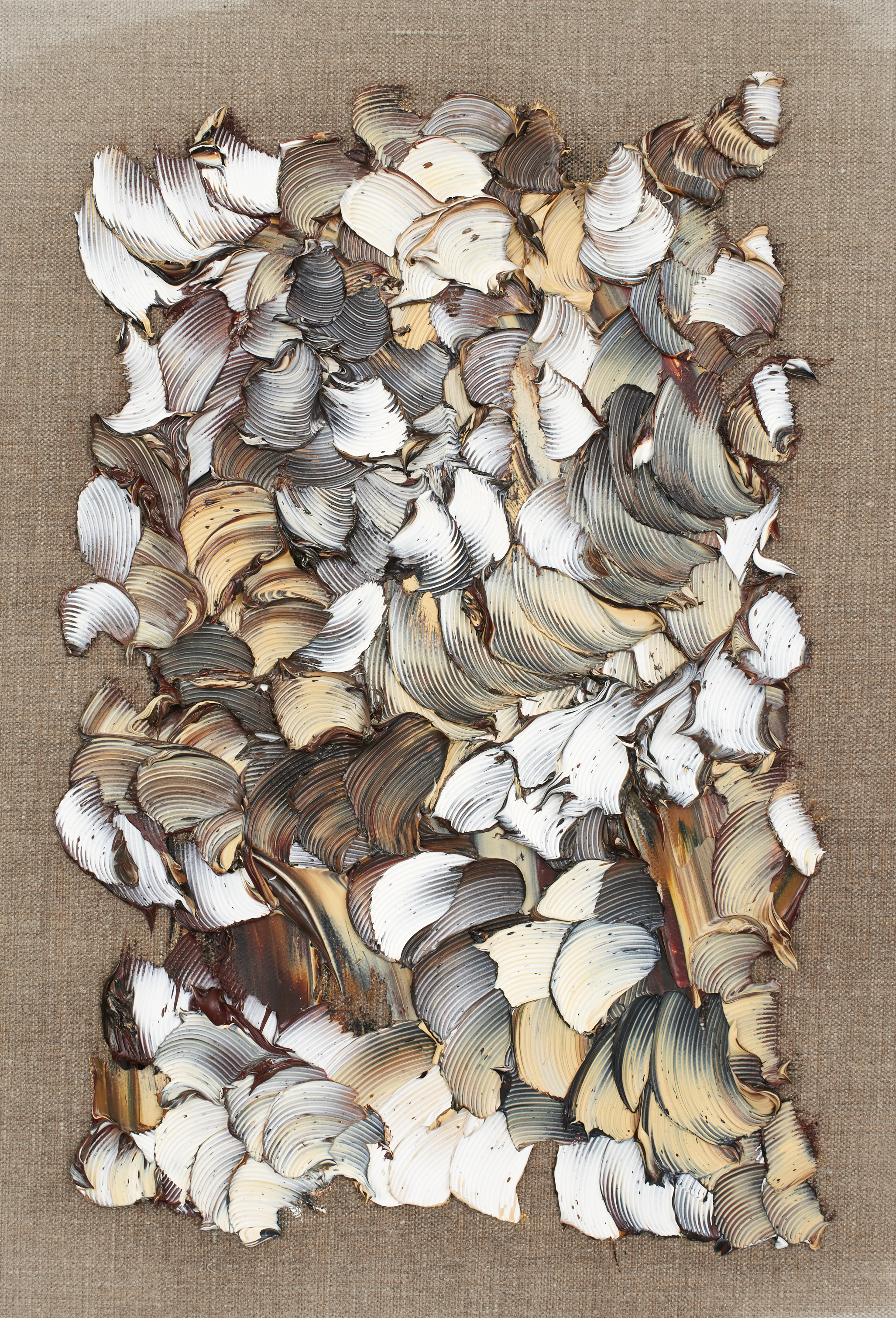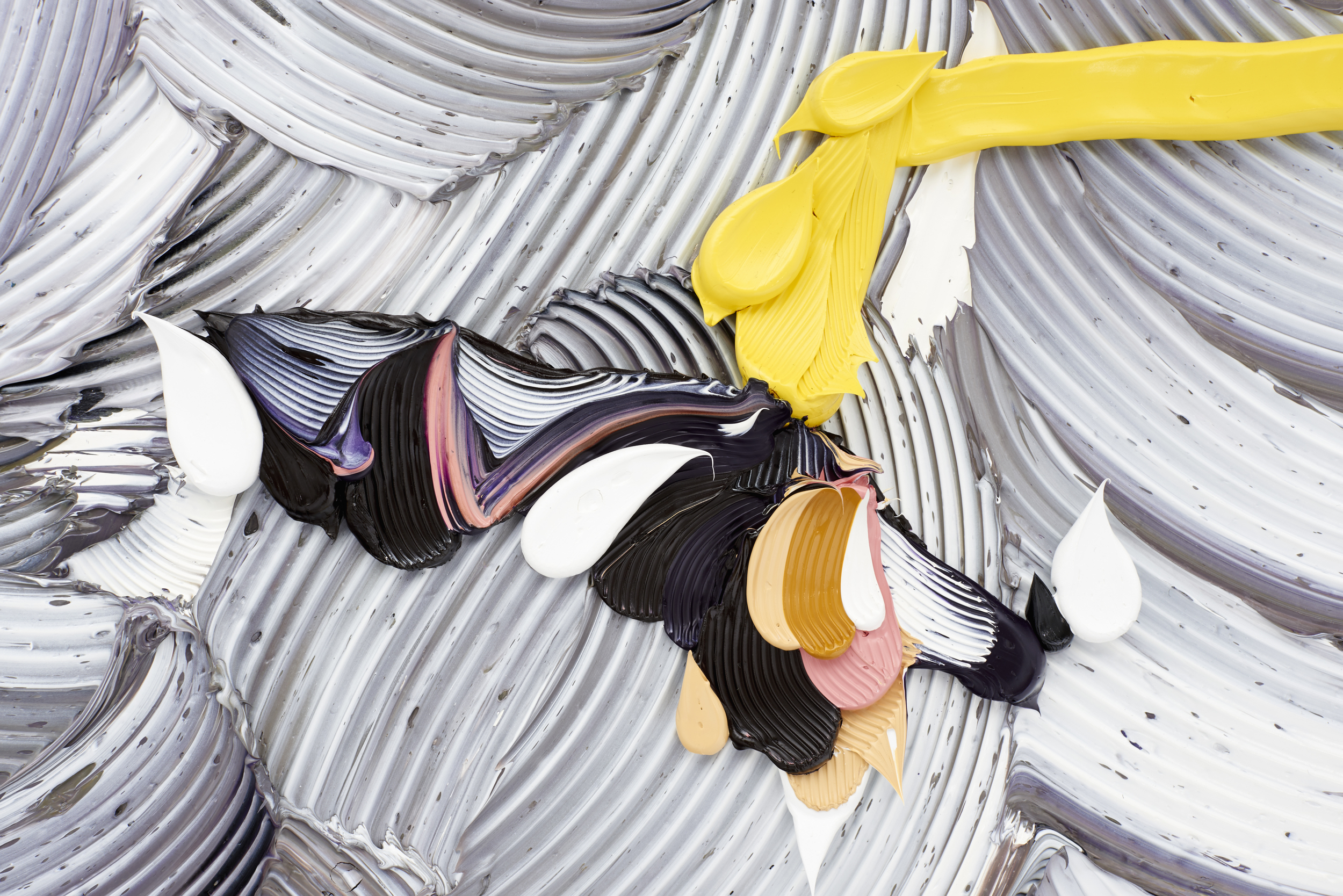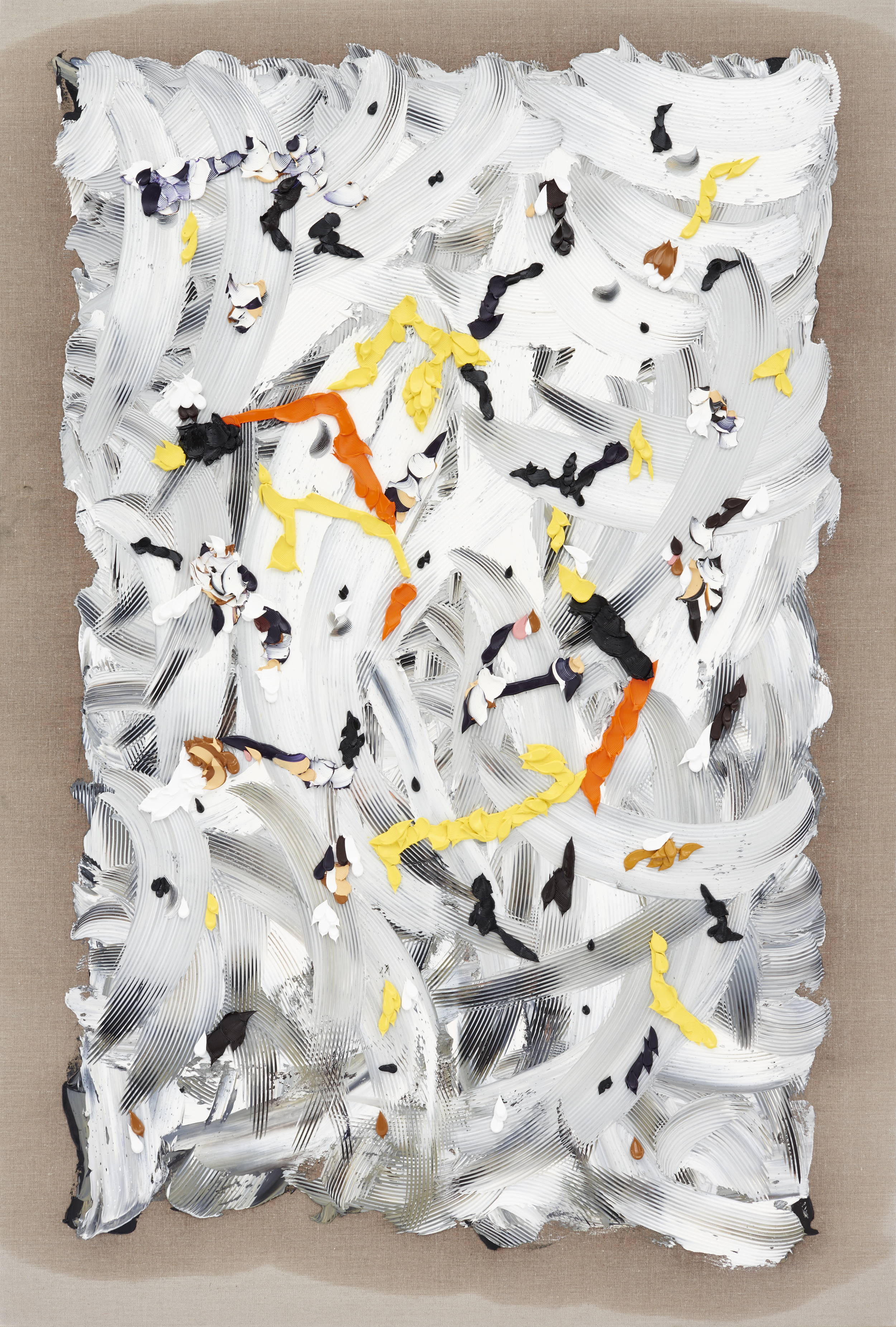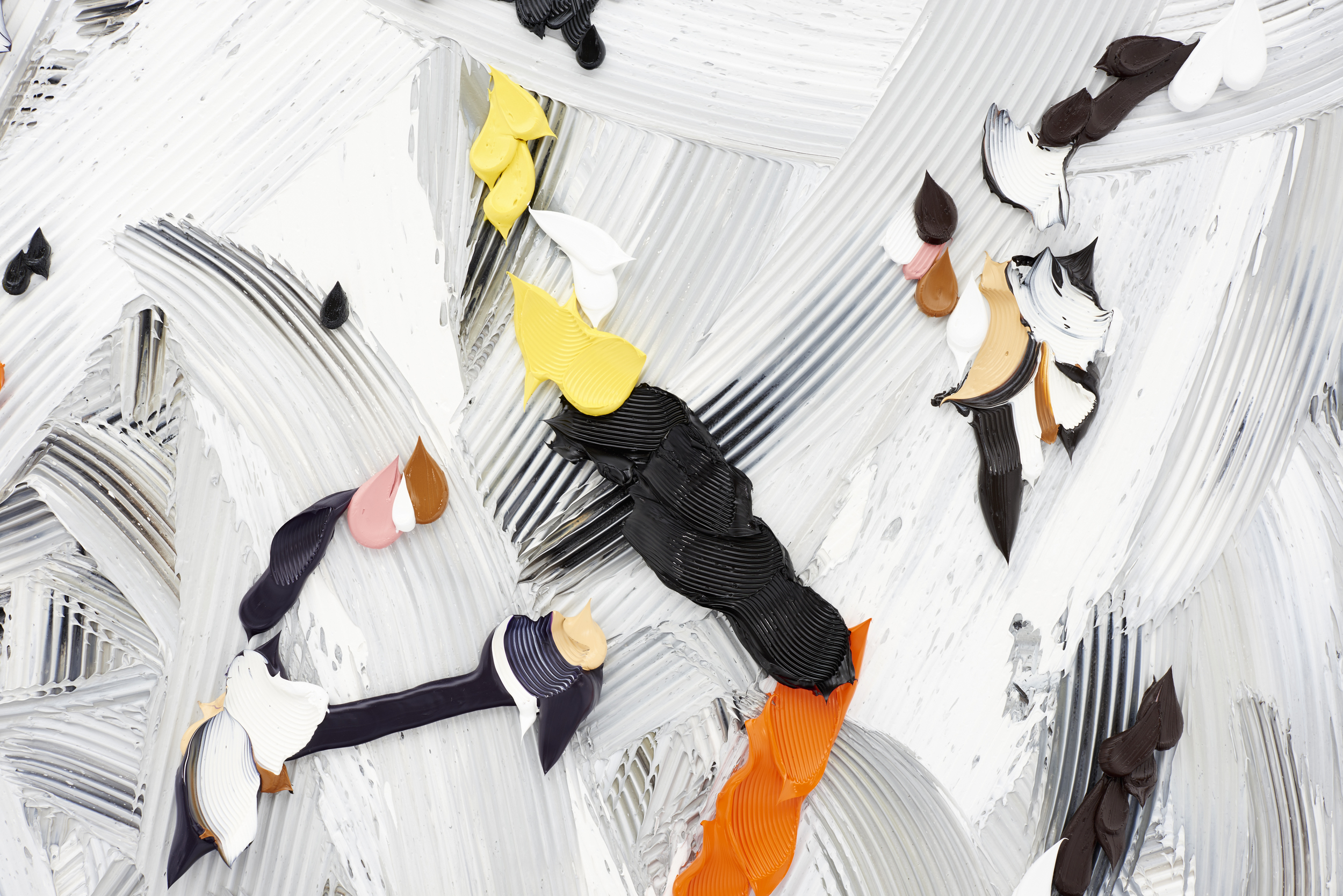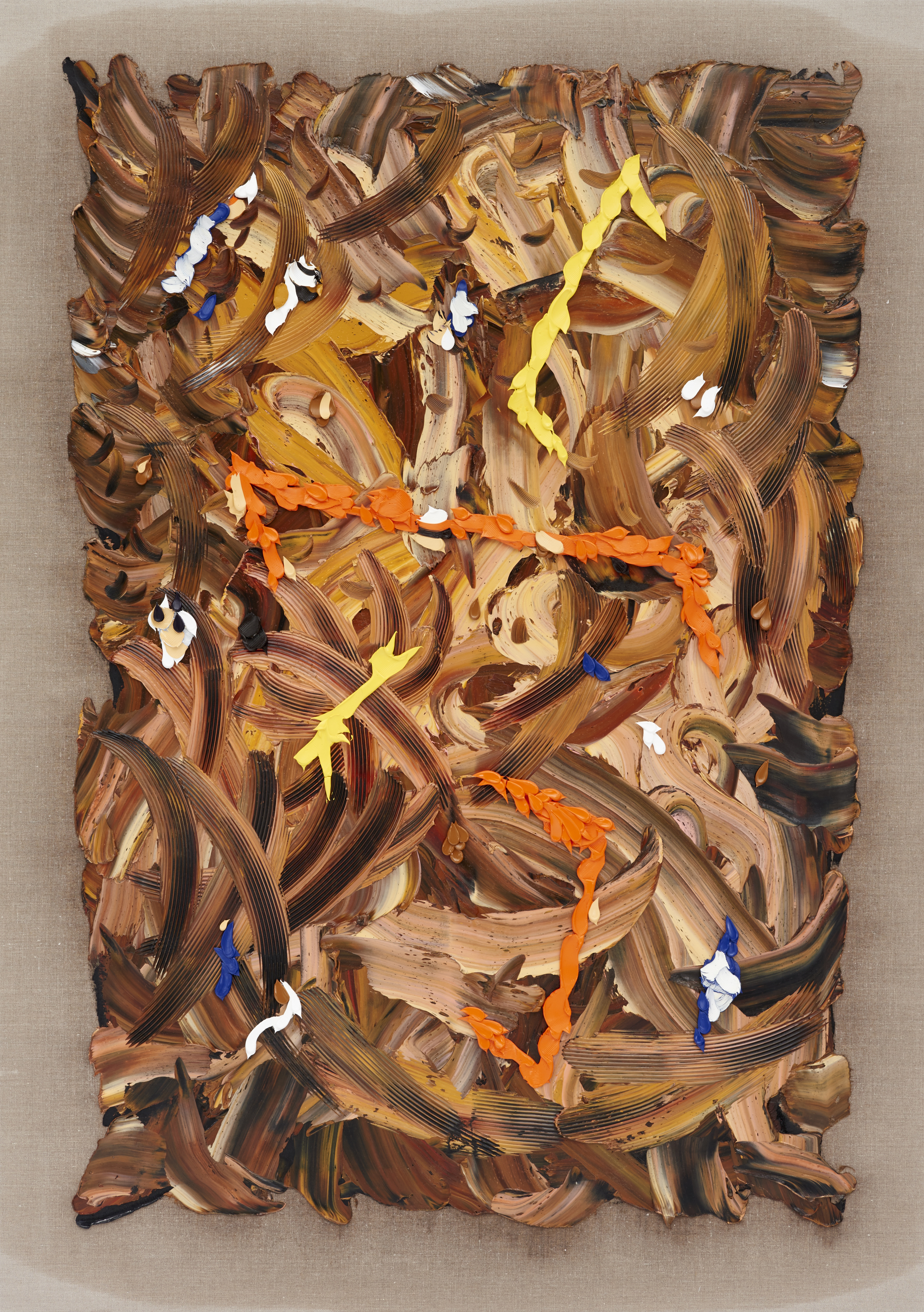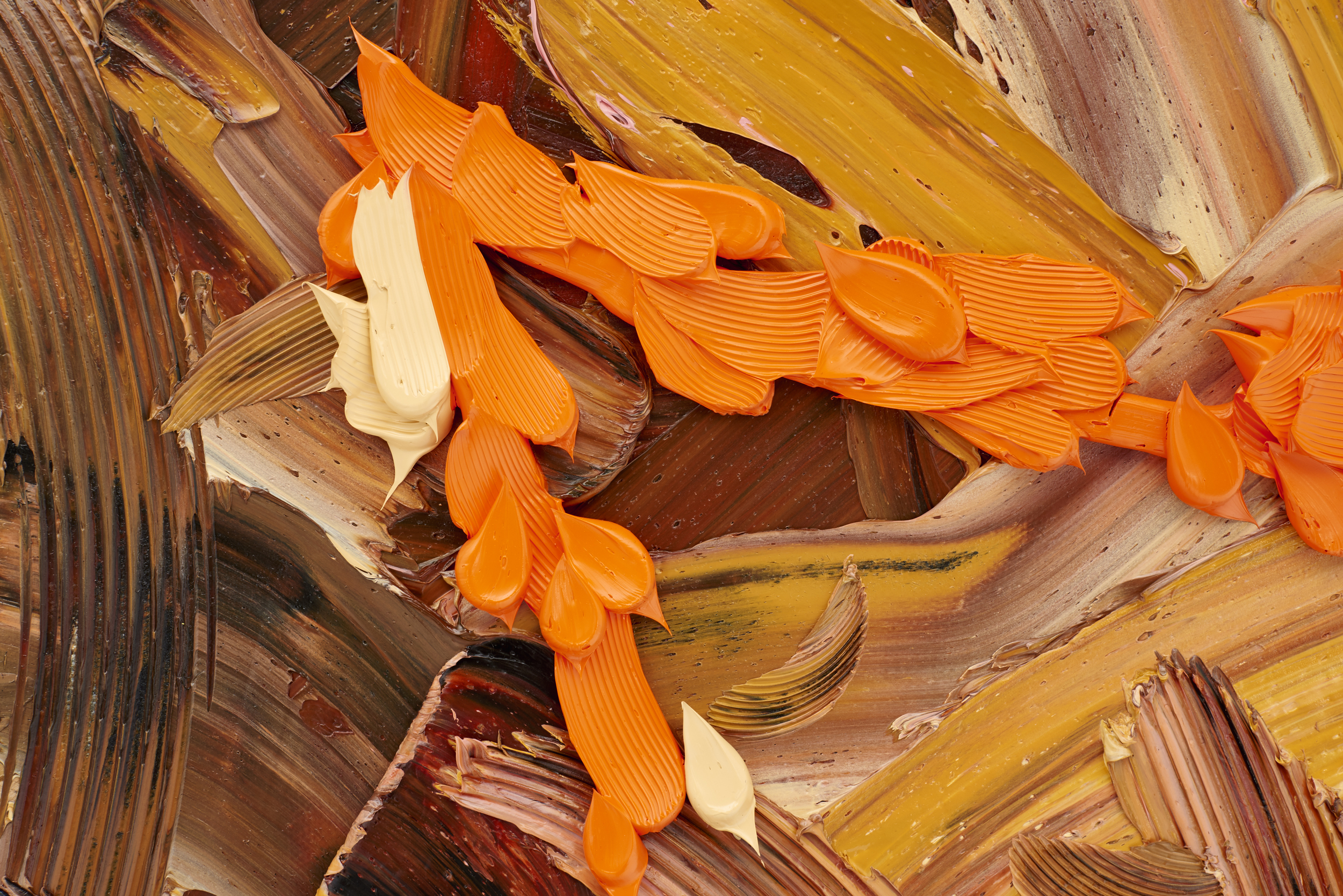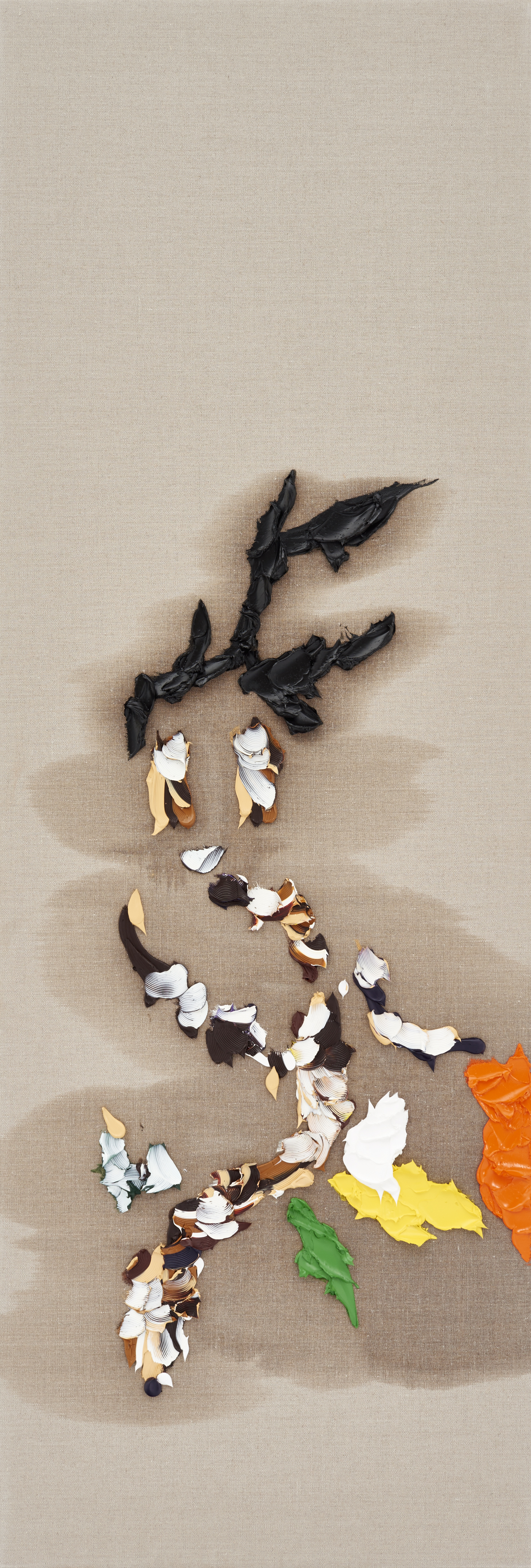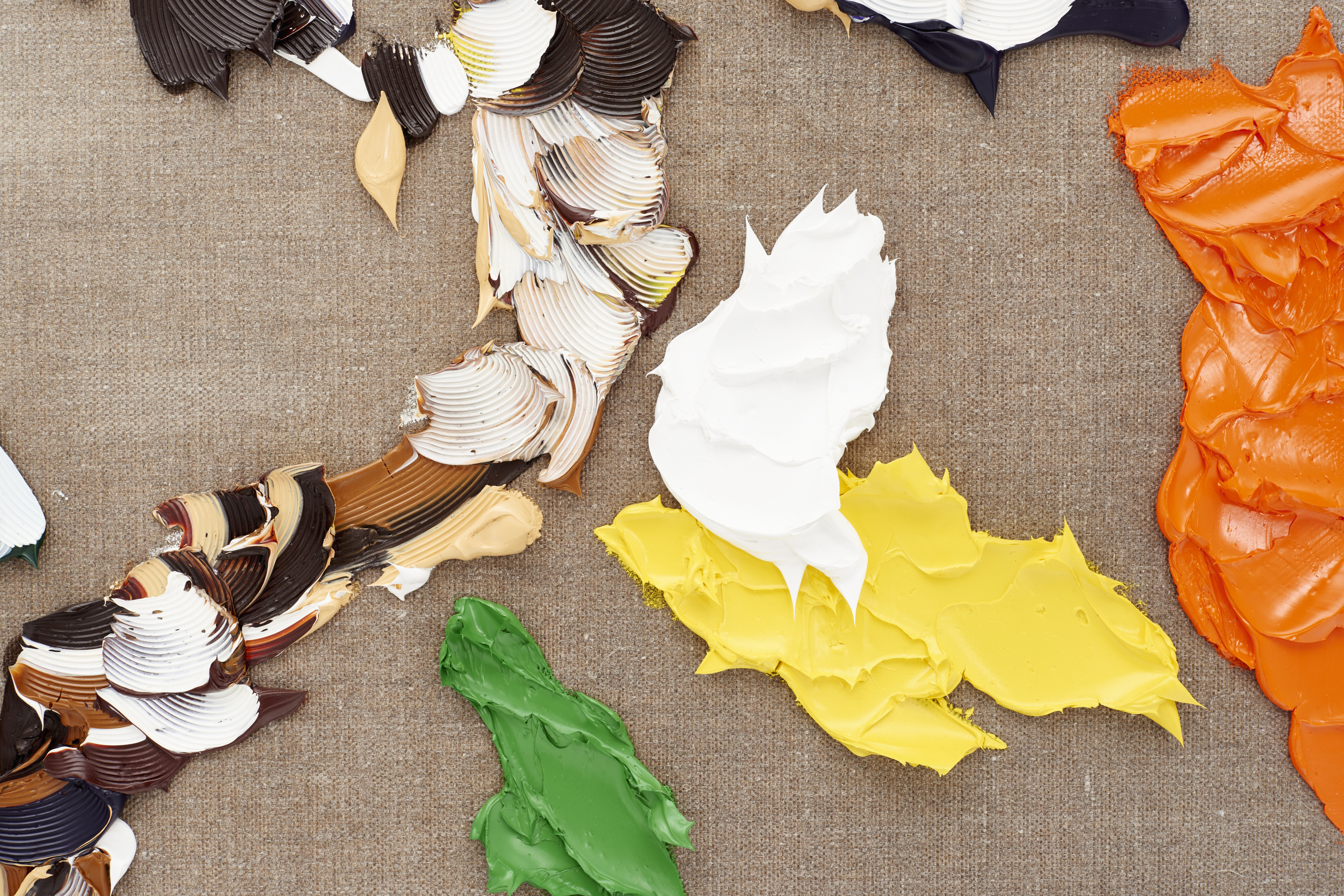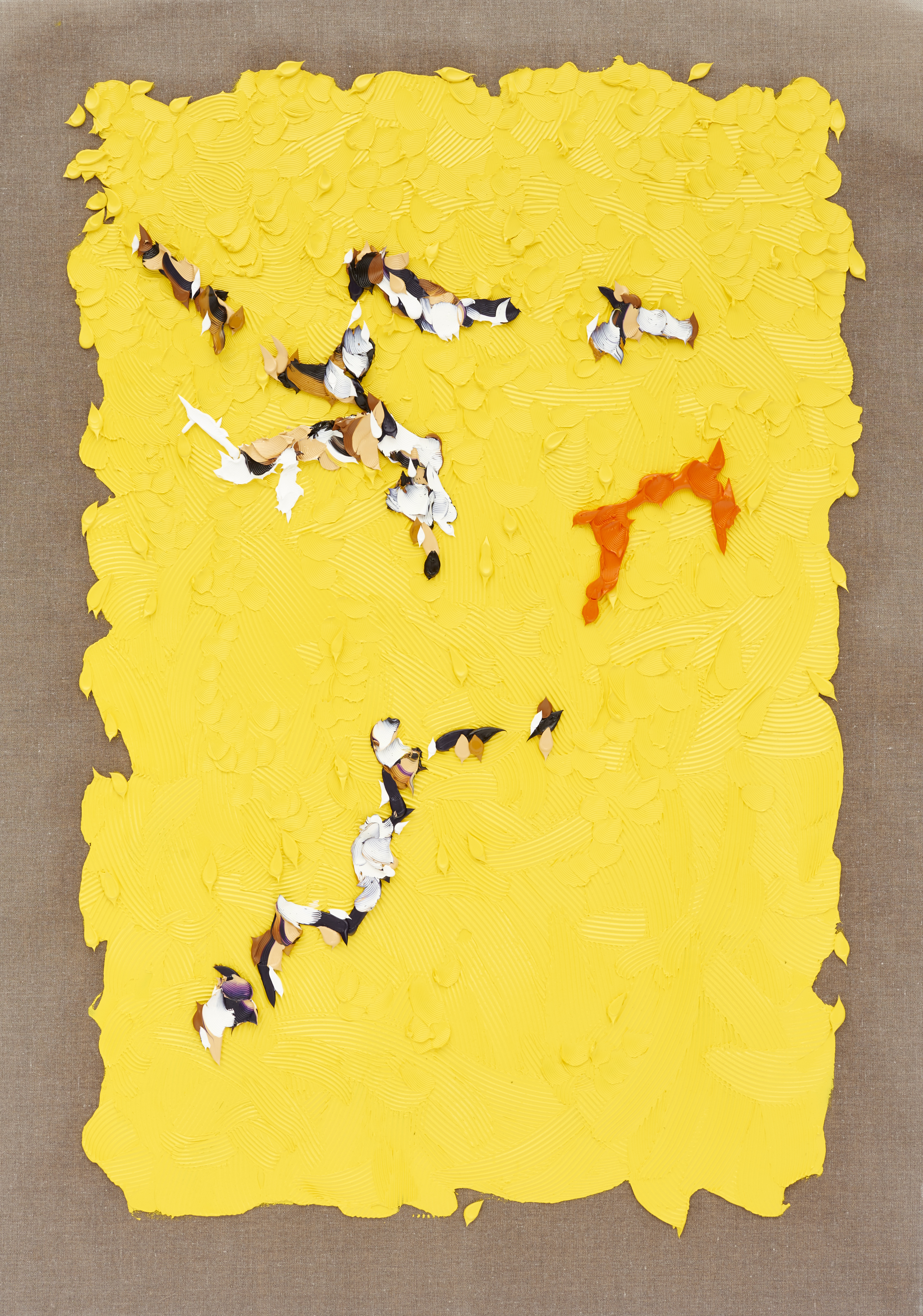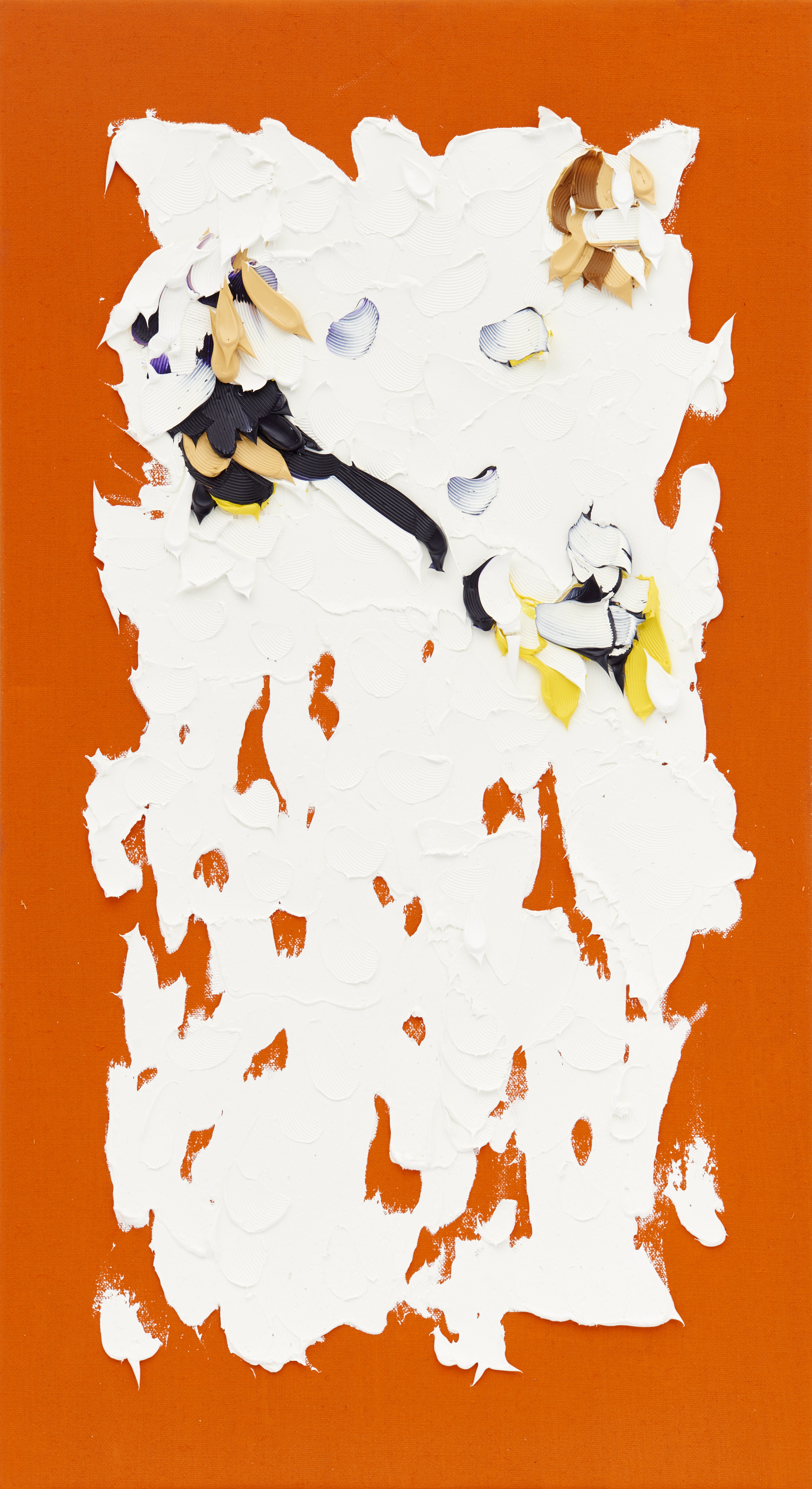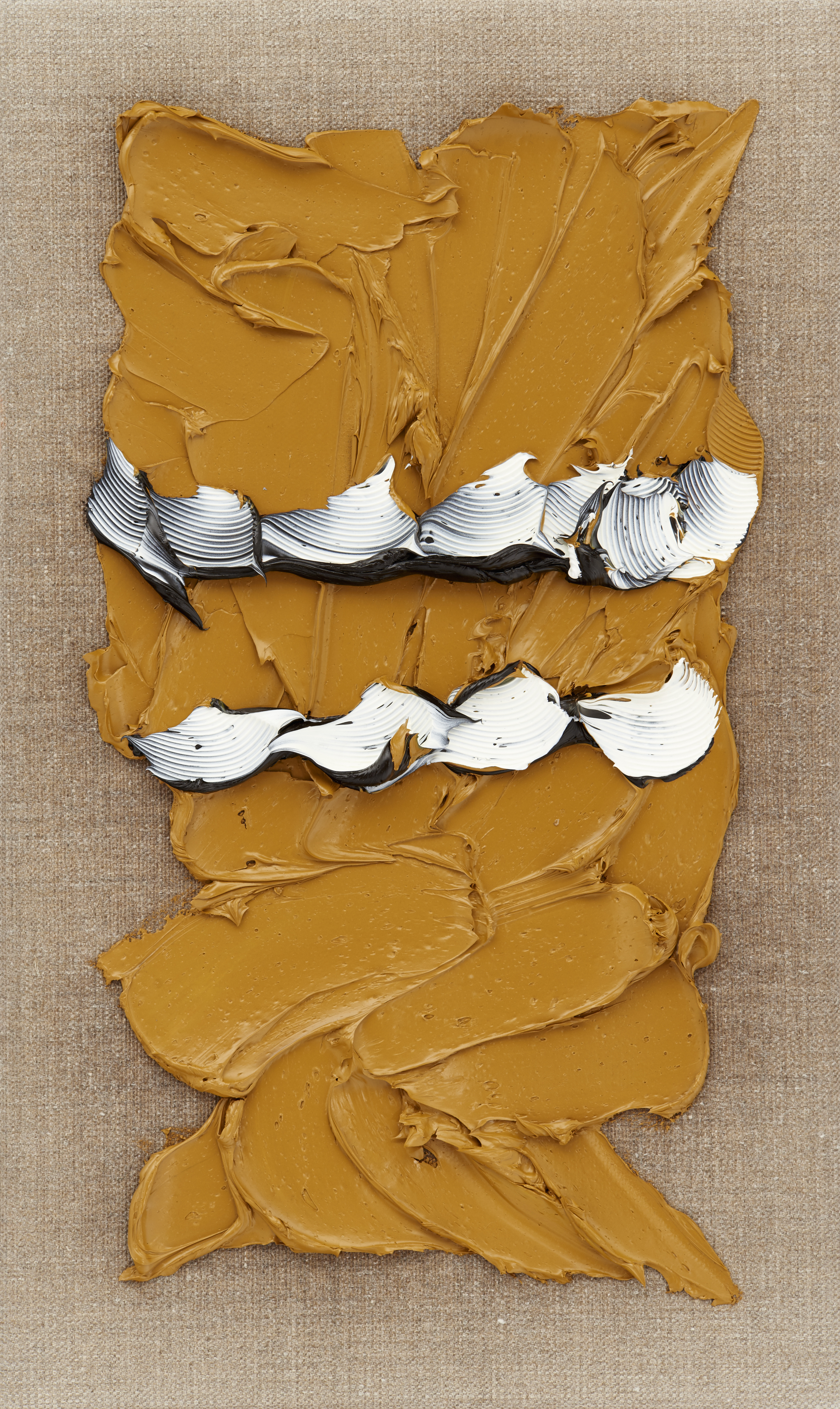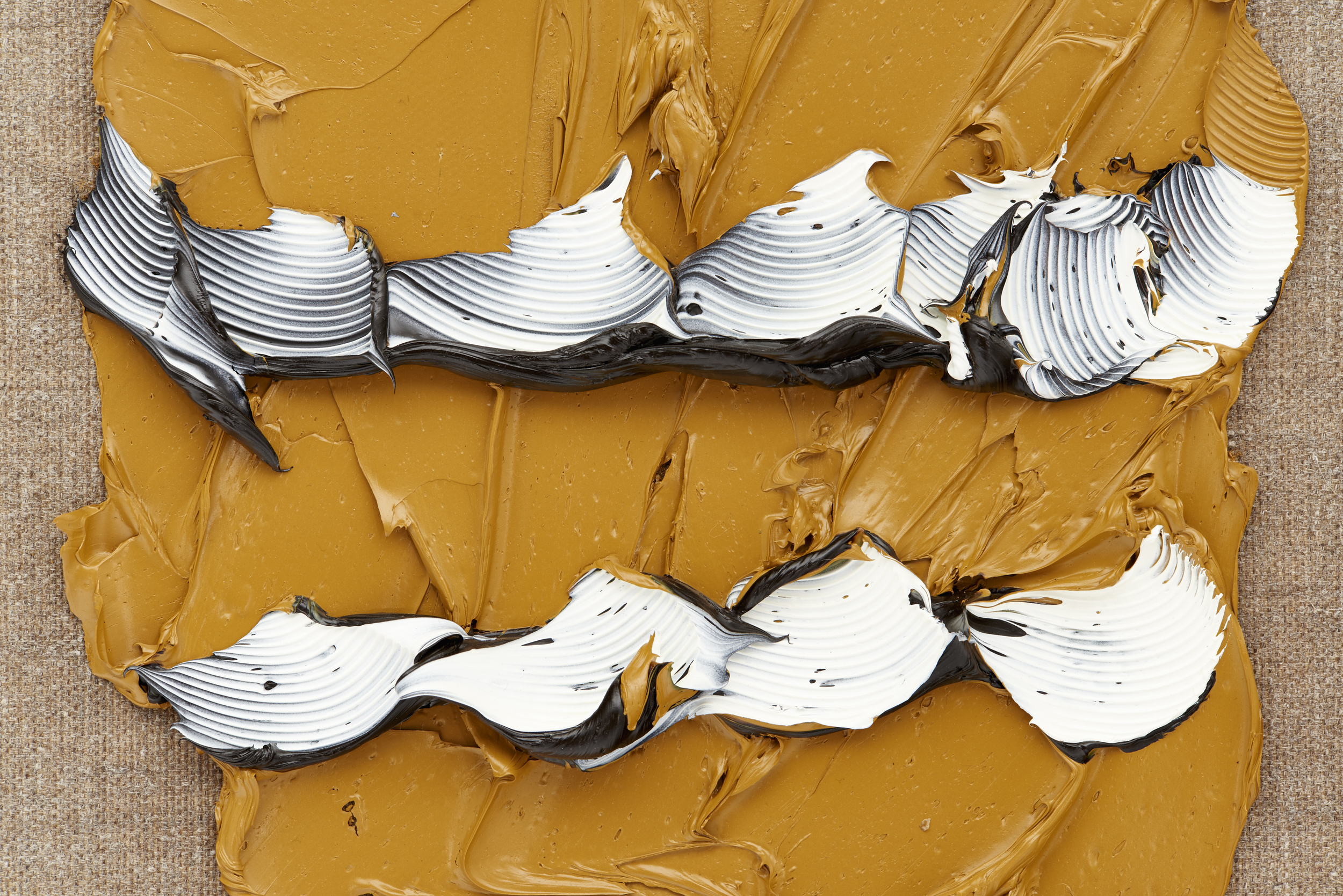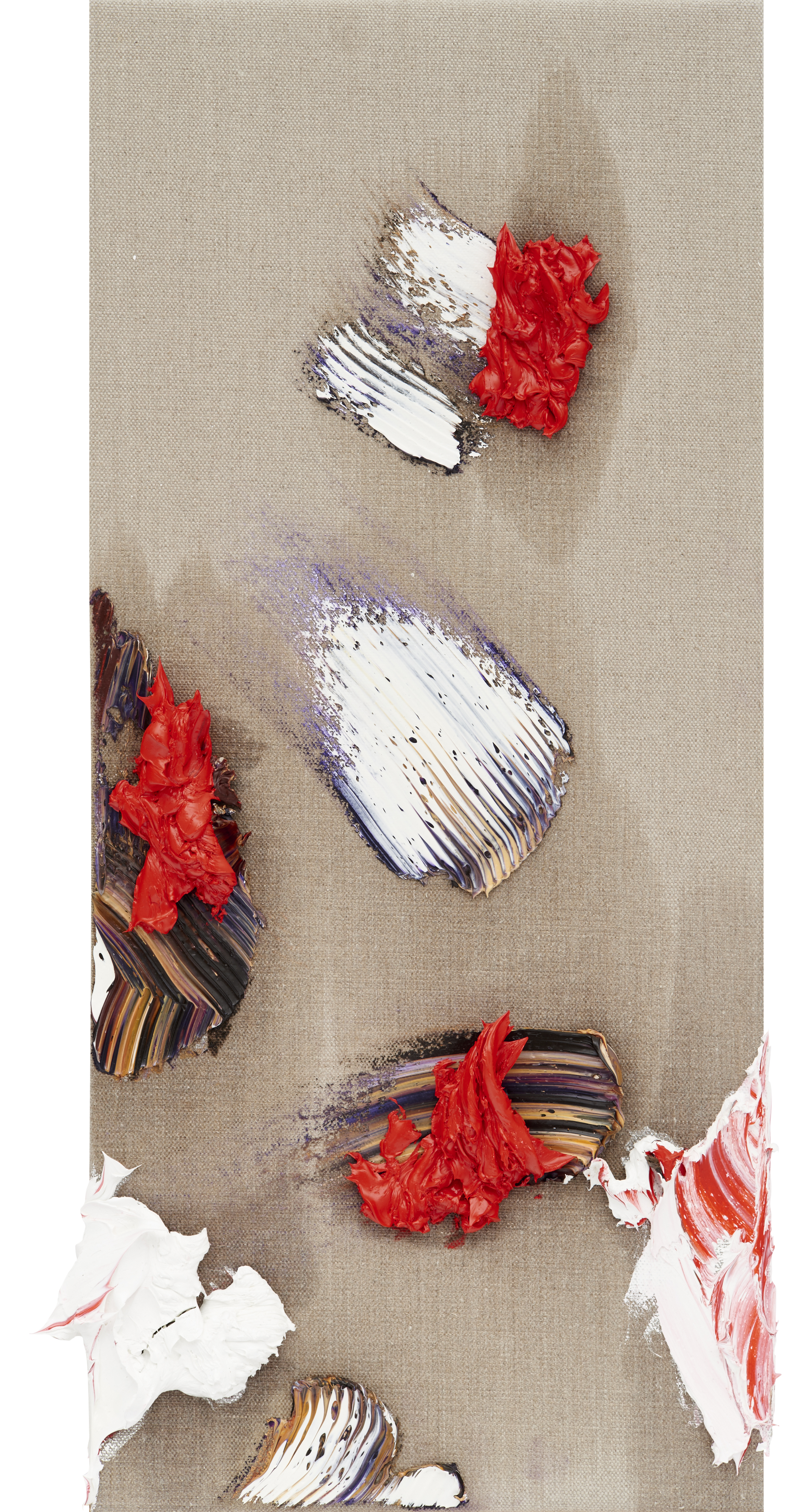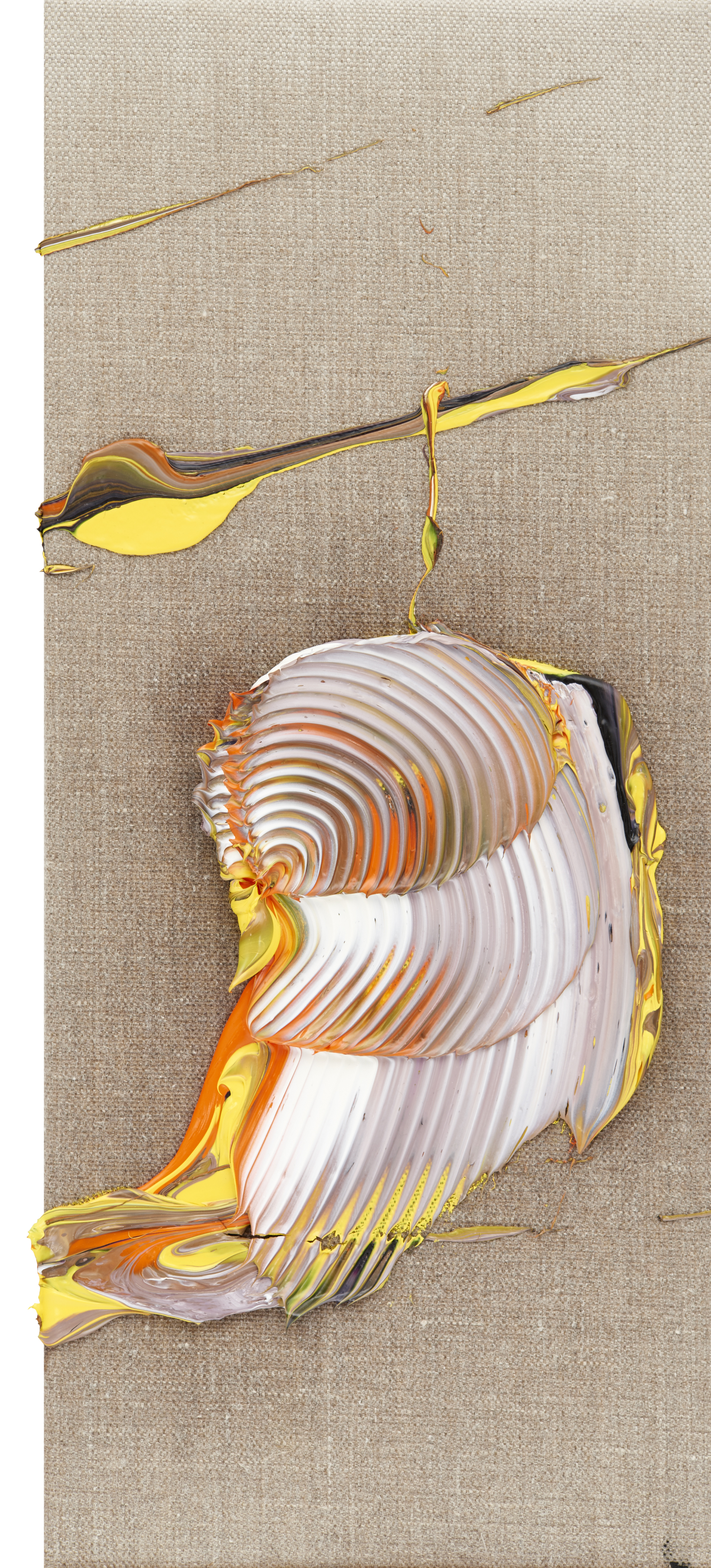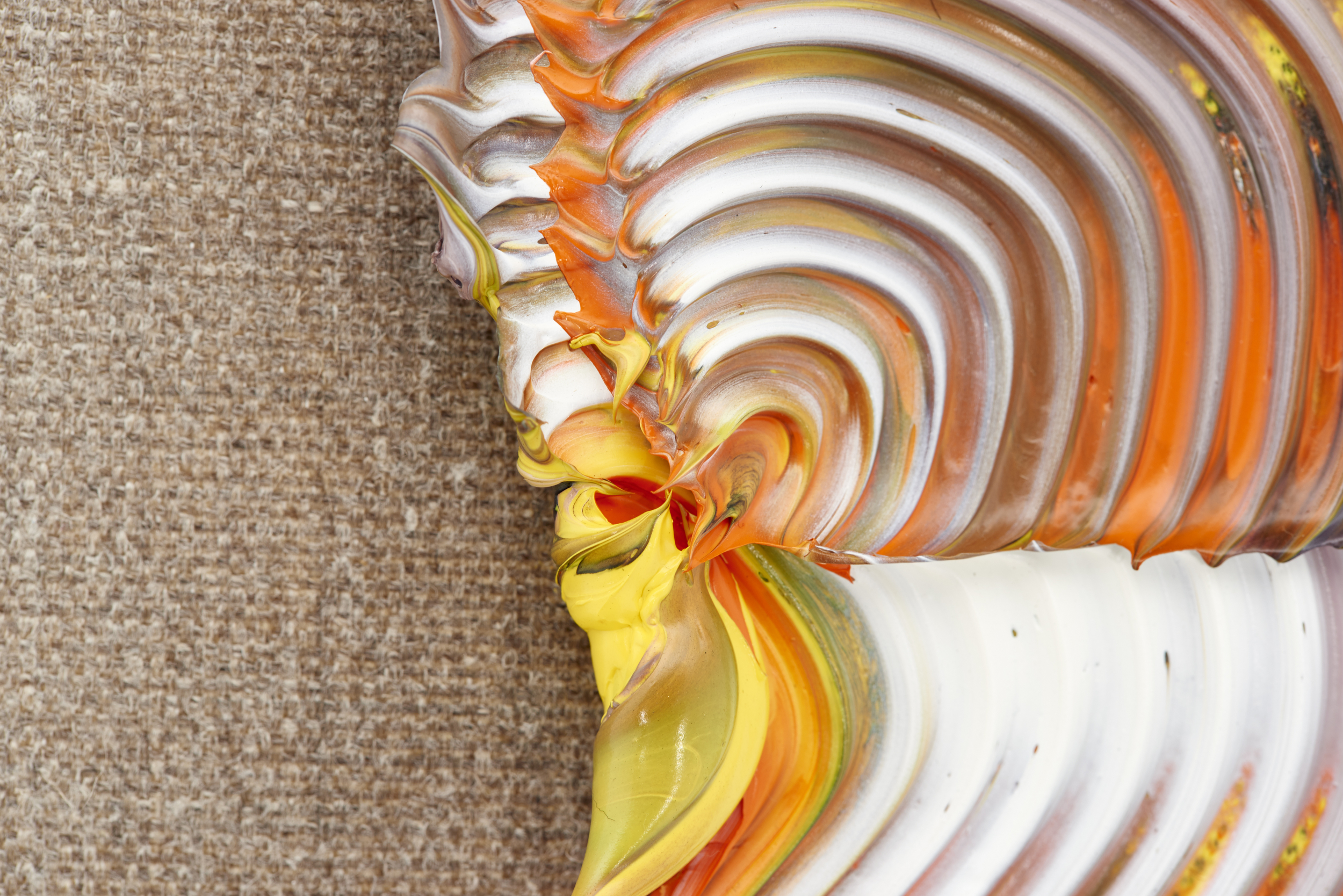This October, South African artist Zander Blom’s recent paintings were shown by Stevenson Gallery at Frieze London. He sits here to discuss process and the intersection between painting and music.
Jason Friedman: There’s something that occurs to me in your work which was much more apparent in the earlier paintings but is still very much there even as the surface has become more lush and that is the importance for you in painting quickly.
Zander Blom: When things go well I begin to do things without almost knowing I’m doing it, I go into the almost opposite of an autopilot. I’m making decisions but I’m making them instinctually. I get the feeling that the faster I work, the more I am able to avoid over-thinking and capable of making less contrived work. So, the obvious thing then is to know when to stop because you are making a million decisions quickly. You have step back, look at it for a while and then go back into it, or decide to keep looking for a longer time and then decide that it's finished.
JF: This seems like something that’s central to your process and the way you talk about this moment in time when you’re making quick decisions chasing something that happens in that first moment as you lay something out. The first moment, the first scrap has something you are after that you couldn’t get to if you were seeking it in a more deliberate way.
ZB: The best stuff comes out that way. And sometimes, labored stuff can be awesome but it can never have that same loose beauty you first put down.
JF: But moving fast in this sense doesn't necessarily mean completing fast, you still have to have this back and forth?
ZB: I move fast so I can catch things and then think about them. You’re right. The process doesn't actually go any quicker. After the initial attack, my critical faculties have to then start working. And what happens is after the oil starts seeping into the canvas—as the painting settles—suddenly this thing that I think is the beginning of something almost completes itself.
I look at it and if I can't find any kind pulse with it and if I can't find a way to improve the composition, I’ll keep scanning it and scanning it; scan it for every little thing that I didn't think of and eventually decide it’s finished or I’ll go back in. It's quite rare that you get lucky right away. It's usually a series of sessions like that when something finally comes together.
“I’m trying to get to where it looks like it painted itself. It’s a form of life doing it’s own thing.”
JF: I had a painting teacher who told a story about Franz Kline and it's something I think about a lot. She was describing a photo where he's on a step-ladder in front of this massive abstract-expressionist piece, she used the phrase, "the seduction of speed", because he's there on the ladder with a tiny brush and he's adjusting the line where this massive black area meets the white. The image he made has this freedom of broad strokes and velocity, but the articulation is actually not that at all, it's something very finely adjusted.
ZB: Right, there's a vitality to it, it looks alive and has this energy. Some images are what they appear, made with that vitality, and some aren't. I suppose with some of the marks they require a fast body movement to get something that looks smooth—if you hesitate you're not going to get that line. But with me, it's so much sculpting with oil paint that it tends to come across—if I'm lucky—more like a thing of it's own accord rather than an artist’s expression. I'm trying to get to where it looks like it painted itself. It's a form of life doing it's own thing. With someone like Franz Kline or Pollock you always feel the artist’s emotion pouring out of the brush and that is very different.
JF: For you the emotion is not connected to the process or it doesn't register as a part of it?
ZB: I don't want it to register as an expression of any kind of angst. I want it to look like some weird bacteria from space you've never seen before.
JF: The raw canvas you’ve been using is really helpful then because it literally is making it's own organic marks in reaction to your more conscious marks.
ZB: Ja, I mean, the raw canvas does a couple of things. First, because the texture is so different from the paint, the painting looks even more plastic when I sculpt onto it. Instead of having paint on paint, it's paint on a material with it's own native color, this beige color. The other thing it does is to spread and create a drop shadow where the oil seeps into the canvas. It lifts the marks, they float; it creates an automatic depth with this surface. Even if you have a splat, it already feels like it's something arrested in space. Like a high-speed camera photographing some kind of natural event. It does have that vitality for me without the brooding expression.
JF: This is interesting to me because it relates a lot to how I think of making music except almost inverted. In sitting, editing, I feel I’m moving toward a moment when this crystallization can happen, it feels a lot like painting to me when I work in the box and on a piece of music in a way that performing or playing with other musicians feels really removed from painting because it never crystallizes, it’s always changing.
ZB: I see, so when you make it slow like that you feel you get back far enough?
JF: Yeah, sitting long enough with the layers, soloing aspects, so even when I’m losing them later, I still maintain some sense of the whole. It's like you said about wanting to paint fast so your hand and brain are connected in this fluid way. I start feeling like I'm slowing my own attention down so that I can perceive things in the track faster, if only because I've spent so much physical time in it. I somehow begin to feel like I'm seeing the whole.
It's still hard though or fundamentally different, because music is time based, you have to enter it on one side and exit on the other. But again, that's why I like the production side, and the process of sitting there and slowly building the track and going in and out because over time I finally get that sense of that. But I wonder how that biological spread could happen in sound? You’ve been making more and more music, how does the way you paint connect to the music you make?
ZB: I’m always relating painting to the music I want to make but there are times when I’m grasping at straws because I’m relating things that don’t relate at all. I want to be able to see the whole thing as a whole instantly like you said, see the structure, see the composition. You can live with the painting and look at different parts everyday and always keep the whole in focus. With music you have to, not only commit time to process the whole, but commit emotionally which painting also doesn’t demand in that way.
It’s hard for me to imagine the music I make achieving this and getting to a place where I can listen to it as something I can enjoy. Like when I reach a point and make a call that a painting is finished, I can re-visit it as an image in a catalogue and then really appreciate it for what it is. It's only then, when I don't have the chance to change it, that it starts to feel I can let go. And then I’m also torn by wanting to make noise that relates much more to abstraction and also wanting to make songs. But, there’s something about making a lot of noise that’s kind of pointless and then there’s something about chasing this perfect three-minute song that’s also ridiculous because you work in this very, very closed set.
I’m somewhere between things that are completely out there, like structure-less weird shit and popular-form trying to find a common ground that feels to me interesting enough but that you would actually want to listen to. I’m curious how one can make something that works but is completely open. The kind of openness I get in painting. The moment a song is locked down, it feels quite dead to me.
The moment there is a beat that locks it down, even if the beat changes or the tempo changes it doesn’t feel like I can listen and hear anything other than what locks it down. Or it’s the opposite and it’s so open that it never takes on anything permanent. This isn’t true in painting, which opens up every-time you look at it but is always also an object in a room. The access points just seem more accessible. What I’m trying to do is something in between those two things and I’m wondering how much of that desire to make something that is listenable because I just want to listen to something like that or is it about wanting to make something that is accessible and familiar because that’s what music is supposed to sound like?
JF: Last year I was looking at a lot of El Anatsui’s work, and I saw him speak here in Brooklyn. I kept thinking what would it be like to make music that sounds like that looks? Not even literally the sound of the sculpture, which obviously has a real sound with the rattling of tin, but something more of an abstract sensibility, like as if you had synesthesia and the music made you picture something as complex as his work. A piece that was somehow non-linear but had defined narrative but still has composition and geometry. You can see it’s materiality but it transcends that to a point where you forget it.
ZB: Oh but that’s great, because it has repetition, it has the bottle caps and the form is a little undefined around the edge…
JF: …and takes on new forms depending on how it’s hung.
ZB: Yeah, I totally can hear it, the shaking layers of texture. The image in my head, and how it’s draped it becomes organic; it folds over as it hits the floor…
JF: Right, so it would pool and in certain moments you would drift in and it would make sense in a certain way but then as a whole there would be really unifying elements of harmonic structure and rhythm. But, what you’re really talking about goes to the heart of what makes painting and music different.
What makes music music are the repetitive bits expressed over time. What you’re talking about, the things that lock it down are the things that move it from noise to music. That’s the difference. Like the old adage, if you fuck up while playing a show, just do it again. Because once is an accident, twice is music.
ZB: [Laughs] Of course. We have heartbeats, and that repetition, and that pulse is the human condition, I understand that but, if I make a painting, I pick a canvas of a certain size. Then you have a surface—a complete empty surface—then you have texture, rhythm and composition and whatever. Within that, the canvas gives you the structure; the canvas gives you the 3:20 song, it exists and then you forget about it. It gives you both the duration and the rhythmic structure.
It’s this defined space within which you can do something but then that structure moves to the background, you almost don’t regard the actual object of the painting. Like you’re describing in Anatsui’s work. Whether it’s figurative or abstract, it’s grounded even though you can reject that grounding. With music, if I adopt those structural limitations, I then can’t get beyond the limitations to get to the right space where I can appreciate what I want to express.
So like, on a piece of paper I can make a really aggressive crude line and that can be all that I draw and as a composition that piece of paper works. It would be like having a perfect 3:20 song that had all the hallmarks of that structure, like a canvas, but is just one long crude note. It’s an impossibility but somehow I keep looking for it. How to be able to express, I don’t know?
“The canvas gives you the structure; the canvas gives you the 3:20 song, it exists and then you forget about it. ”
JF: Because you want the openness? Because you want to have as few gestures as possible to express something?
ZB: No. It’s not that, it’s that the contained space of a paper or canvas, the frame, already provides this locked thing that gives the painting or drawing familiar context and access at the same time that it’s totally forgettable because we take the structure for granted. Where as, music can go on forever and ever and ever.
JF: Right. And the rhythm or the arrangement when it takes on aspects of that clear structure it limits it in a way that makes you directly aware of the limitations.
ZB: It’s harder to contain and also make something that is open at the same time. And still a gallery show still has some of the qualities I like about records. You walk into a show and the paintings are almost like songs. You check this one, check that, skip that one because you’re just not into it, keep going back to one. I don’t know the experience is similar to records but still, for me, when I try to work on music I just keep searching for the same expression and feeling I get from painting.
JF: Hmmm’ well for me, I often start just by making arbitrary decision. Like an oblique strategy, this is how fast it is, this is how long it is…
ZB: …It’s 120 bpm, 8 bar loop…
JF: Yeah, that becomes the canvas—from a making perspective—I work within some set of structure and limitations to start and it’s only later once that space has become more defined that I start to deconstruct or re-position or whatever and then multiple states or places emerge from the first instance.
ZB: So, what you’re explaining is that you almost have a roll of paper or canvas that you’re unrolling as you go. You’ve got the surface—which is the tempo—and then you have the size—which becomes set by the length—and the form which is the crude mark or whatever and it’s determined as you roll it out.
JF: Something like that but with the freedom to re-cut it at anytime or change the dimensions…
ZB: …the tempo.
JF: It can be like shifting from one size canvas to another. But, it’s almost like I’m starting over at that point and the first attempts really become like a sketch even if I’m still in the same session. Especially if the tempo is radically shifted, some things will immediately not work at the new scale.
ZB: Of course.
JF: But really what you’re talking about I guess has more to do with how you experience the finished track you’ve made and less about the making of it? And because when you make music, like with your painting, you’re mostly improvising and making decisions about the music after the fact, you’re looking for it to coalesce into a new form, like with oil spreading on the canvass reacting to what you’ve done. For me, somehow the letting go or accepting of some of the idioms of rock n’ roll or the 3:20 song, somehow it’s enough to give me that feeling of the canvas. Like, the beat when it hits and it’s right locks you in and you forget about the structure in the same way I forget about the object of the painting. The beat becomes a part of my body.
ZB: I get that, you make a track, you’ve built your spaceship but you can build the interior anyway you like and the exterior but the structure is there. But one thing that I find problematic is this difference between the transcendent quality paint has for me, the paint becomes something alien or otherworldly, but sound often can’t escape its physicality. Like you said, if anything it goes backwards.
For instance, if I’m trying to come up with something like an original guitar sound. The more it goes onto a side that I like the more it becomes un-listenable to everyone I know and muddles the whole sound. It feels like trying to imagine deeper space in a very limited space. Because, with a guitar, I want to make something that doesn’t sound like a guitar because I don’t like a really normal electric guitar plugged into an amp sound but nothing really feels like that thing I’m searching for.
I keep relating it back to similar techniques I use when painting. When I moved from painting on white primed canvass to painting on linen, my whole world changed completely and suddenly it worked. Paint on paint looked dead, but paint on a textured warm surface suddenly sparkled. So, I keep thinking of sound, the sound of the recording and the sound of the instrument—however you make it—are equivalent to what materials you use when painting. Which has a big effect on whether the image is successful or not.
JF: And this idea that music can be an object at all is all still a really new way of thinking about music. In The Recording Angel, Evan Eisenberg talks about how before recording, and going back to the beginning of human history, music was thought of as the purest of art-forms because it never crystallized, because it only existed in the moment you perform it. Recording actually moves music and painting closer together than at any other point in human history, music becomes an object. Before recording, you couldn't own it, you couldn't rewind back to the moment, even when you played the same song again, it was literally different the next time.
ZB: So it was always a moment and then it's gone, boom.
JF: And between performing and recording the physics of the sound is always mutating too. I’ve made guitar sounds that feel like I am getting to an otherworldly place and then I record it and it doesn’t sound anything like what I thought it sounded like. And that’s the thing, when you’re actually working to create a sound in a space, it’s vibrating more than just your eardrums, your whole body is involved.
But, let’s back track a bit. You’ve really become focused now as a painter but when you sort of emerged you were playing with installation and linking even more directly to music and more, let’s say conceptual based work, were you painting at the time that you were doing the installation work?
ZB: I'd been painting throughout but none of the paintings I made then felt interesting enough to me, so I was doing a bunch of shit, video art and the weird installation shit in the house which was sort birthed out of not really having gallery shows and not having a place to show but I really wanted to build things on a scale. This is a long story but I'll try and cut it short.
I moved from Pretoria to Joburg and I decided not to take my computer with me because I had been trying to do this video shit for a long time and I was sick of staring at a computer all day. Instead, I decided to just do drawings. This also helped because I was broke but could afford paper and ink. I moved to Joburg with a mattress and I had this room and then I just made all these ink drawings that filled the room. I started photographing the drawings just to keep track of what I was making because I would need to take them down to make new ones.
The drawings turned into collages and the collages turned into these installations it just organically happened. I got a slightly better camera and then a slightly better camera from a friend. As my ability to photograph the work got better I also got more interested in making the photograph. I would build the installation. Photograph it and build another with the idea of making a book of all these photographs of what I was building in this bedroom. Which is great. One day you build this thing, you photograph it and the next day you break it down and build another and it allowed me to be quite productive but not need to have a big studio or make bronze casts or anything.
What I really liked about it was that the thing that came across was the idea of "just fucking do something with whatever you got". You don't need access to a massive studio or a massive gallery to be productive or to make work of a certain scale, you can make something above the bed and as I say, this really worked for me at the time because I didn't have those massive spaces or cash. It's cool when it comes together in a way that still translates.
But at some point I had to let go of the sort of context the photograph provides because you can make anything and photograph it and it will look cool—zoom out, re-frame it, include more of the environment so you have all this stuff that adds to the "painting". The challenge I think is to make something compelling with limited stuff or context, because as much you are limited just building something in a room, with a photograph the room itself is doing some of the work. To remove that and make the marks work with their own context on the canvass, that was the challenge.
“What I really liked about it was that the thing that came across was the idea of ‘just fucking do something with whatever you got.”
JF: So what was the shift then? Where did the point come when suddenly painting was starting to make sense?
ZB: It kind of slowly happened. I was doing a lot of really polemic based work. The first was the Drone Of Progress. That was sort of looking at modernism but also reflecting on the context. Having grown up with all the modernist stuff—Mondrian, Picasso and all that—my natural inclination was to mimic it. I felt like I was studying the masters in a way but from this weird position as a young dude in Joburg making this shit in his house. And the idea was to make a kind of fictitious catalogue survey going through elements of this formalist enterprise.
After I finished that I decided to do something that was again about modernism but that was more focused not on the idea of progress and abstraction but more about the exotic element in modernism, things that came from the periphery of Western Culture but enabled those artists to break away from the European traditions. Like they needed this to say fuck you to the history of reclining nudes. I was interested in that and it became The Travels Of Bad which I made into this rock opera. I wanted to frame it in a very throw-away pop culture way to say, you know the idea of Gauguin going to Tahiti to find the "primitive new flavors" to transform the center, I kind of equated that with this masculine bravado and stupidity like a hair-metal band. I thought it was quite funny. You know the ridiculous mythology of these crazy absinthe-drinking geniuses who argue about art and whatever I just thought that was funny and not that different from the guise bands adopt.
You can go see a small band in a shit gig but because the energy of the club, and the people, and the booze and the nice time, you’re loving it. If you make a painting and you put it in a gallery, the white cube space neutralizes the moment so you’re forced to engage in a different way. With music, or bands, it’s more of a mythology around everything that gives it it’s meaning. The video, the shirt, the images. and you can’t separate the music from the event where as with painting, you do separate the work from the event and you put it in a clean space where it almost becomes this incredible object because you are neutralizing context. But then at the same time, the mythology of the artist genius, the business of the art genius is really the same. That brings you to the market and something when it gets so big that it functions in pop culture, there's much more focus on the image of the artist than the work itself.
JF: Right, right, the purpose of the art world is to pretend to create a context that takes you outside of mundane concerns. Like a cult of the neutral, there is only the object. But obviously, people get obsessed with mythology of certain artists, Basquiat or Van Gogh’s biography for example, but the idea is to champion art that transcends our time in some way. Music is much more overtly focused on the biography and with questions of authenticity and context in a much more direct way. First drafts of lyrics and memorabilia that gets appraised like holy relics.
Somehow though, like you said, all of this biography evolves to deepen your connection to unknowable moments and the music is just a part of that puzzle. I feel like in painting, the opposite happens where the more famous the ancillary products of the artist’s life become, it almost cheapens the work making it harder to see. Biography impedes on the white space but it’s also what ultimately gives the art monetary value even as it destroys the meaning of the piece of art.
ZB: We're side-tracking completely now but I was watching that Pollock movie with Ed Harris the other night and my feeling was "was he really like that or do they just portray him like that in post?" I kept thinking was he really as much of a moron as they make him out to be? Drinking, fucking, “I'm a genius.” was he really like this? The movie makes him out like he's never read a book in his life; he's just this pure primitive creature. It doesn't seem like he was really that thing. But the other aspect with someone like Pollock is how Clement Greenberg pushed him and the other guys into this direction of where he thought art should go.
JF: He sold them, these days that would be called brand development.
ZB: It was a dogma and an ideology he pushed on the work itself. It seems we're post any one voice. Someone like Hans Ulrich Obrist has replaced that kind of roll but he doesn’t force his ideology on the artists. For the most part, everything is multi-flavored, you still have the big dudes but they're far more distinct. You have Jeff Koons, Paul McCarthy and on and on. It's a totally capitalist idea of progress. You can't copy Jeff Koons because there is no school of Jeff Koons it's just Jeff Koons. Everyone has their corner of the market and young artists are looking in trying to find a style which no one else has claimed.
JF: It often seems very limiting or old fashioned, those modernist ideas of art, where it was this ism or that ism but at the same time I wonder if we collectively have a harder time getting to that ephemeral place you are speaking of, the place where the rules don't make sense? Are we too attuned to the surface or the immediate context of an art object, does it all get reduced to its simplest meaning? Does it all become product and an eclectic decorative-art jumble? We still very much have isms left but it’s Tumblrism, #ism, or like a Google ad, you stand in the gallery, “Okay Google, who is Mondrian?” and a little screen pops up in front of the painting you were looking at. The ism is still the intermediary.
ZB: I think that's where capitalism and the art market comes in. Art gets made in isolation and somehow needs to define the opposite; needs to define inclusion. And with music and art now, you have the internet which connects everything and you have a device between you at all times, the same device to look at a painting or listen to music, it all filters through the same device. It’s this illusion that we are all connected and talking to each other.
I want to be in my own little world and I want to discover weird shit when I walk out of the house. I don’t want it to all look exactly the same, I don’t want the same emotional commitment for everything. It’s so alien to me. I understand what makes it lucrative and I love being able to download lectures about random shit for free, I love that, or that we’re using this right now to talk like we are in the same room, but there’s an aspect of it that’s shit.
“As an artist you have to resist that to a degree, you have to work to keep changing and demanding your gallery accept the changes or you do just become a brand. ”
There’s another side of the art market which is also frustrating and which makes it very difficult because what happens is instead of being generally able to do whatever you want and waiting to see how the interesting things emerge, what happens so much is that you hang-up something you do, the market responds, and they want more of that from you and only that from you. So, you're the “bubblegum guy” and that's what you do and you can't stray from that. As an artist you have to resist that to a degree. You have to work to keep changing and demanding your gallery accept the changes or you do just become a brand. I feel I have to actively keep other people or demands out of my head. There are things I can take from other people's opinions, obviously, but the moment that I do something because that is what the market or the gallery want, I've fucked myself.
But okay, so, we've totally sidetracked. You asked how did I get to painting? I said first I did the Drone Of Progress which was the installation stuff all about formalism and all of that and then I did the Travels Of Bad which was more a thesis on exotic culture and it's artifacts in modernism and at the same time I was also painting but only in little bits.
JF: Was that because you didn't know what exactly you wanted to do with it?
ZB: Yeah, I had no idea what to do with it. The great thing about building the installations was that I could make a bunch of marks on the wall without having to make decisions and then photograph it. The marks are essentially just abstraction but the moment you photograph it, it becomes something completely different. When I was making marks on a canvas it just looked like some fucking boring abstract painting. The thing that happened with the Drone Of Progress was that I started making marks on the wall because I didn't want to make a figurative painting, didn't want symbolism and all of that which just seemed meaningless to me. I wanted to make paintings but wasn't sure what I wanted to say. There was resistance art and William Kentridge which was all associated with the struggle and all of that, but that had already happened so it was a question, what are you going to make art about?
I started doing marks to avoid making a picture. That began for me taking all kinds of pop art images, cutting them up, reducing them to sharp lines and circles, chopped it up to get interesting compositions. Because you can't make an abstract picture without it immediately being connected to modernism it sort of became about modernism and growing up with modernism. What do you do with abstraction if you want to make abstraction because it's modernism? Then I did a third series which I called the Black Hole Universe. I was over that super colorful satire shit. I wanted to do something more minimalist and inspired by films. I was looking at scenes from space movies and say, Frank Stella. I was feeling the minimalism and space thing.
So this was series that doesn't have this polemic—a film without a narrative or structure. I did that, I enjoyed that, but at that point the painting started to go well. I think I had worked through a whole bunch of shit and I found the process of painting on linen. It had almost the same thing that making marks on a wall and then photographing it had. That surface, somehow gave me what white primed canvas hadn't. The oil stains, the environment the marks, suddenly, the paintings started working.
JF: I have this problem. I have a deep affection for minimalism and abstraction but I have a hard time doing it myself without building it off a structure, a folk or pop structure, that structure gives me so many markers to build around, it gives me the entry to hang abstract elements around.
But then, I think popular form is that relationship already, a weird combination of dissonance and harmonic structures. Even in big pop hits there’s parts that are outside the aesthetic norm and it fluctuates back and forth between clarity and chaos. It becomes abstract on a less immediate level.
So, was it like this in a way, was the structure you had created, the space film without narrative, did that just end up being an oblique strategy for getting into the painting and developing the technique to where it was telling it's own story and didn't need that kind of polemic or structure?
ZB: Ja, I needed those hooks, the cut up references from pop culture etc. they were like guides that allowed me to get to this place where I didn't need this narrative. Drones Of Progress, Travels Of Bad had these stories so the film without a narrative was a cool way to frame it. It came about when I had the opportunity to do some residencies outside of South Africa which normally I would avoid but, I had been making these installations in my house and I thought, why don't I make a project where I do photographs but they're only in different cities abroad?
The idea was to ignore the city but focus on the room I was in and do different chapters for the film in all these cities around the world. It was cool, but I was getting bored with it. After going all these places, I wanted to go back home and just paint. In the end, painting was just so much fun. I had been doing painting on the side for so long and it took me so long to get to a point where I thought the things I made were actually successful. I didn't want to go anywhere; I wanted to be home painting.
Making a physical object that's compelling that you see happen right before your eyes as opposed to building something, photographing it and then spending ten thousand hours on the computer grading it and going through them to select the best one with the best lighting and printing it. The process sucked so much compared to physically making a painting and having the object.
JF: I can relate. So, the lesson of that whole process of getting you there is in patience, developing these side inquires and letting them evolve and direct your course?
ZB: Having faith, get up in the morning and make something, get up the next day and have faith even if it's month or a year, have faith that it will get better or lead to something else, something you can't know yet.

